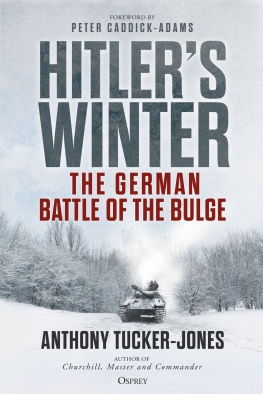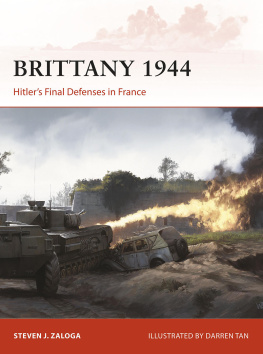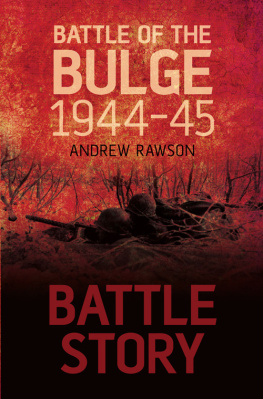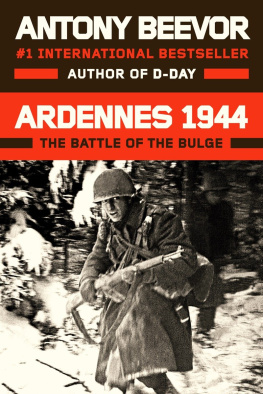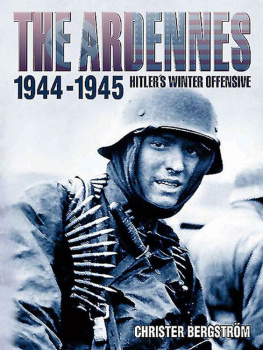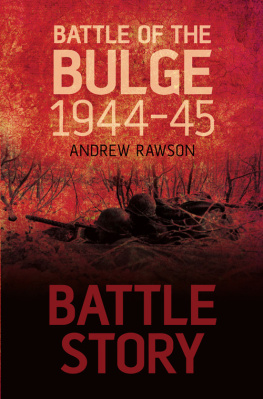Voices From the
BATTLE OF THE BULGE
Voices From the
BATTLE OF THE BULGE
Nigel de Lee
Foreword by Major General Michael Reynolds CB
Voices From the Battle of the Bulge
This edition first published in 2018 by Greenhill Books
c/o Pen & Sword Books Ltd,
47 Church Street, Barnsley,
S. Yorkshire, S70 2AS
Publishing History
First published in the UK by David & Charles in 2004
www.greenhillbooks.com
ISBN: 978-1-78438-317-6
eISBN: 978-1-78438-318-3
Mobi ISBN: 978-1-78438-319-0
All rights reserved.
Main text Nigel de Lee, David & Charles 2004,
an imprint of F&W Media International LTD, Pynes Hill,
Pynes Hill Court, Exeter, Devon, EX2 5SP, UK
Foreword Major General Michael Reynolds CB 2004
Front cover image SS Panzer Grenadiers at the Battle of the Bulge colourized by Jon Wilkinson, Pen and Sword Books.
The right of Nigel de Lee to be identified as author of this work has been asserted in accordance with Section 77 of the Copyright Designs and Patents Act 1988.
CIP data records for this title are available from the British Library
FOREWORD
By the autumn of 1944 Hitler knew that he had no hope of successfully defending his Greater German Reich against both the Western Allies and the Red Army. He resolved therefore that before turning his full fury on the Russians, he would take one last desperate gamble by launching a major offensive in the west. The fact that he was committing Germanys last reserves in men and resources gave the operation an air of finality - even he predicted that the outcome of this offensive would bring life or death for the German nation.
Hitlers plan called for three armies to break through the weak American front in the Ardennes and Luxembourg and then to cross the Meuse river and exploit to the great port of Antwerp. This would cut off the First Canadian, Second British and Ninth US Armies, deprive the Allies of their most important port and hopefully cause mass surrenders. Indeed, Hitler saw it as the basis of another Dunkirk.
The Battle of the Bulge, as it became known, was the largest land battle ever fought by the US Army. It began early on 16 December with a barrage by over 1,900 German guns and rocket launchers, following which a total of seven Panzer, two Parachute and 11 volks-Grenadier Divisions were unleashed on a 90-mile front against just five American divisions. The Germans pitted some 200,000 men, 700 tanks and armoured assault guns against an initial 83,000 Americans who had just over 400 tanks and tank destroyers.
By the tenth day of Hitlers offensive the Germans had penetrated about 60 miles; but the average width of the Bulge had already been reduced to 30 miles and its tip measured no more than 5 miles across. The Americans had poured in reinforcements, notably two airborne divisions and the bulk of George Pattons 3rd Army and as Chester Wilmot put it: the [Nazi] spearhead lay broken in the snow. The Germans had looked upon the Meuse for the last time.
By the end of January 1945 the Bulge had been eliminated. The costs to the Americans and Germans were roughly the same - about 80,000 men and 700 tanks. There was, however, a vital difference - the Germans had reached the limits of their strength, while the Americans had not. Hitlers chance of saving himself and the Third Reich had vanished.
This book is not a history of the battle as such. Rather it is the raw material from which history is made - a collection of memories of what it was like to be involved in the conflict. These memories are extremely varied because, in such dramatic and exciting events as these, experience and recollection cover a wide range, from the tedium and misery of sitting in a foxhole in freezing cold to the intense mixture of terror and elation of being in action. By reading these vivid accounts it becomes possible to imagine what it was really like to take part in, and to witness first hand, the decisive battle that put an end to Hitlers hopes of avoiding defeat in the West.
Major General Michael Reynolds
(Author of three books on The Battle of the Bulge
The Devils Adjutant, Men of Steel and Sons of the Reich.)
1
HITLERS LAST GAMBLE
According to his devoted followers Adolf Hitler was an infallible military genius. His critics and enemies regarded him as a reckless adventurer, lacking the professional training and prudence of the true strategist. With hindsight we can say he was a gifted amateur who was lucky in the early stages of his career as supreme commander of the German armed forces. But by autumn 1944 his luck was running out. Germanys military situation was desperate. In the east the Red Army was rolling across Poland towards Berlin. In the south the Allied armies in Italy were advancing towards the alpine frontier of Austria. In the west the American and British armies were closing on the Rhine.
The Ardennes offensive of December 1944 was the gamblers last throw of the dice. The competent professionals in the German High Command never believed that the plan for Wacht am Rhein had a chance of success, but were unable to persuade Hitler to give it up. On 3 November 1944, Field Marshal Hasso von Manteuffel attended a conference at the HQ of Army Group B at which Colonel General Alfred Jodl, Chief of Staff at Oberkommando der Werhmacht ( - Supreme Command of the Armed Forces), produced a draft plan, together with sketch maps for a decisive offensive to be launched against the Western Allies.
The aims of the plan were ambitious: to push two Panzer armies through the wooded hills in the middle of winter, then move on to take Antwerp, the greatest port in Europe and vital to the supply of the Allied armies. This bold thrust would separate the British 2nd Army from the American armies, cut it off, and force another evacuation by sea - a second Dunkirk. Such a disaster would demoralize the war-weary British people. If this did not force Churchill to negotiate a compromise peace it would at least gain time for the V-2 and other miracle weapons to sap the will of the British to carry on. As for the Americans, Hitlers racial prejudices led him to believe that they were morally weak and would collapse if caught unawares by a surprise attack.

Field Marshal Walter Model, a dutiful and committed Nazi and Hitlers personal choice as commander of the attack, was at odds with the Fhrer throughout, constantly seeking permission for the best military solutions but regularly having his plans rejected or changed.
Field Marshal Gerd von Runstedt, the overall commander in the West, felt that the plan was not a practical operation and tried to persuade Hitler to accept a small solution in which the aim of the offensive would be to gain the banks of the River Meuse running along the western side of the Ardennes. He argued that a successful advance to the Meuse would have a similar shock effect but at much lower cost and risk.



